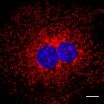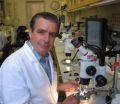(Press-News.org) Tomato plants use similar biochemical mechanisms to reject pollen from their own flowers as well as pollen from foreign but related plant species, thus guarding against both inbreeding and cross-species hybridization, report plant scientists at the University of California, Davis.
The researchers identified a tomato pollen gene that encodes a protein that is very similar to a protein thought to function in preventing self-pollination in petunias. The tomato gene also was shown to play a role in blocking cross-species fertilization, suggesting that similar biochemical mechanisms underlie the rejection of a plant's own pollen as well as foreign pollen from another species.
Roger Chetelat, director and curator of UC Davis' Charles M. Rick Tomato Genetics Resource Center, and Wentao Li, a postdoctoral researcher in the Department of Plant Sciences, report their findings in the Dec. 24 issue of the journal Science.
Their discovery will likely find application in plant breeding, particularly for California's $1.5 billion tomato industry, and in developing a better basic understanding of the biology of pollination.
"Flowering plants have several types of reproductive barriers to prevent accidental hybridization between species in nature," Chetelat said. "We have identified one piece of this puzzle, a gene that helps control whether or not tomato pollen is recognized and rejected by flowers of related wild species.
"Understanding and manipulating these reproductive barriers might help breeders access desired traits found in wild tomatoes," he said.
Not all pollen is welcome:
In the mid-1800s, naturalist Charles Darwin observed that many flowering plants reject pollen from their own flowers as well as pollen from foreign plant species — the first because it is too similar and the other because it is too different. They do allow fertilization, however, between two plants of the same species.
In plants, as well as animals, breeding between closely related individuals is generally considered detrimental because it leads to the expression of harmful mutations and leaves subsequent generations genetically ill equipped to deal with environmental changes or diseases.
And crossbreeding with individuals from different species can be equally detrimental because it frequently results in hybrid offspring that cannot reproduce.
During the past several decades, scientists have studied the molecular mechanisms that cause plants to reject their own pollen. They have found that in the Solanaceae (nightshade) plant family, which includes tomatoes, prevention of self-pollination is controlled by the "S-locus." This is a genetic region responsible for producing distinct proteins in the flower's pollen and in its pistil, the female organ where pollination occurs.
While this mechanism for preventing self-pollination has been relatively well characterized, the mechanism that prevents crossing with plants of other species is much less understood.
The UC Davis study:
To explore these processes in the tomato plant, Chetelat and Li set out to locate the chromosomal regions harboring genes that control fertilization and can cause a plant's flower to reject pollen from other species. The researchers identified a gene expressed in pollen known as a "Cullin1" gene, which interacts genetically with a gene at or near the S-locus to block cross-species pollination.
They found that a mutant (inactive) form of the Cullin1 protein is present in cultivated tomato, as well as in related red- and orange-fruited wild tomato species, all of which are capable of being fertilized by their own pollen. However in the green-fruited tomato species, most of which block self-pollination, the Cullin1 protein is functional.
In short, their findings suggest that the Cullin1 protein is part of a biochemical gatekeeper: An active form of the protein is required for pollen to fertilize plants of another species, if that species is capable of rejecting its own pollen.
While these findings are from a study of tomato hybrids, the researchers suspect that they will be relevant to other members of the Solanaceae family, which also includes potatoes, chili peppers and eggplant.
###Chetelat and Li are members of the multicenter Interspecific Reproductive Barriers in Tomato research group. This consortium of six laboratories throughout the United States is investigating how tomato plants block cross-species pollination, in order to provide the scientific community with tools for better understanding reproductive biology. More information about the research group is available at http://irbtomato.org.
More information about the Charles M. Rick Tomato Genetics Resource Center is available at http://tgrc.ucdavis.edu.
Gatekeeper for tomato pollination identified
2010-12-24
ELSE PRESS RELEASES FROM THIS DATE:
Gene alteration in mice mimics heart-building effect of exercise
2010-12-24
BOSTON--By tweaking a single gene, scientists have mimicked in sedentary mice the heart-strengthening effects of two weeks of endurance training, according to a report from Dana-Farber Cancer Institute and Beth Israel Deaconess Medical Center (BIDMC).
The genetic manipulation spurred the animals' heart muscle cells -- called cardiomyocytes -- to proliferate and grow larger by an amount comparable to normal mice that swam for up to three hours a day, the authors write in the journal Cell.
This specific gene manipulation can't be done in humans, they say, but the findings ...
Electronic medical records not always linked to better care in hospitals, study finds
2010-12-24
Use of electronic health records by hospitals across the United States has had only a limited effect on improving the quality of medical care, according to a new RAND Corporation study.
Studying a wide mix of hospitals nationally, researchers found that hospitals with basic electronic health records demonstrated a significantly higher increase in quality of care for patients being treated for heart failure.
However, similar gains were not noted among hospitals that upgraded to advanced electronic health records, and hospitals with electronic health records did not ...
How cells running on empty trigger fuel recycling
2010-12-24
LA JOLLA, CA—Researchers at the Salk Institute for Biological Studies have discovered how AMPK, a metabolic master switch that springs into gear when cells run low on energy, revs up a cellular recycling program to free up essential molecular building blocks in times of need.
In a paper published in the Dec. 23, 2010 edition of Science Express, a team led by Reuben Shaw, PhD., Howard Hughes Medical Institute Early Career Scientist and Hearst Endowment assistant professor in the Salk's Molecular and Cell Biology Laboratory, reports that AMPK activates a cellular recycling ...
Kidney disease patients: Eat your veggies, reward your kidneys
2010-12-24
Phosphorous levels plummet in kidney disease patients who stick to a vegetarian diet, according to a study appearing in an upcoming issue of the Clinical Journal of the American Society Nephrology (CJASN). The results suggest that eating vegetables rather than meat can help kidney disease patients avoid accumulating toxic levels of this mineral in their bodies.
Individuals with kidney disease cannot adequately rid the body of phosphorus, which is found in dietary proteins and is a common food additive. Kidney disease patients must limit their phosphorous intake, as high ...
You are what your father ate
2010-12-24
WORCESTER, Mass. — Scientists at the University of Massachusetts Medical School and the University of Texas at Austin have uncovered evidence that environmental influences experienced by a father can be passed down to the next generation, "reprogramming" how genes function in offspring. A new study published this week in Cell shows that environmental cues—in this case, diet—influence genes in mammals from one generation to the next, evidence that until now has been sparse. These insights, coupled with previous human epidemiological studies, suggest that paternal environmental ...
UCLA researchers uncover new cell biological mechanism that regulates protein stability in cells
2010-12-24
The cell signaling pathway known as Wnt, commonly activated in cancers, causes internal membranes within a healthy cell to imprison an enzyme that is vital in degrading proteins, preventing the enzyme from doing its job and affecting the stability of many proteins within the cell, researchers at UCLA's Jonsson Comprehensive Cancer Center have found.
The finding is important because sequestering the enzyme, Glycogen Synthase Kinase 3 (GSK3), results in the stabilization of proteins in the cell, at least one of which is known to be a key player in cancer, said Dr. Edward ...
Heat shock protein drives yeast evolution
2010-12-24
FINDINGS: Whitehead Institute researchers have determined that heat shock protein 90 (Hsp90) can create diverse heritable traits in brewer's yeast (Saccharomyces cerevisiae) by affecting a large portion of the yeast genome. The finding has led the researchers to conclude that Hsp90 has played a key role in shaping the evolutionary history of the yeast genome, and likely others as well.
RELEVANCE: Over the past several years, Whitehead Member Susan Lindquist has built the case that heat shock proteins (Hsps), which are found across species from bacteria to humans, are ...
SU scientists find that in the evolutionary mating game, brawn and stealth rule
2010-12-24
When prowling for a hook up, it's not always the good-looker who gets the girl. In fact, in a certain species of South American fish, brawn and stealth beat out colorful and refined almost every time.
In a series of published studies of a South American species of fish (Poecilia parae), which are closely related to guppies, Syracuse University scientists have discovered how the interplay between male mating strategies and predator behavior has helped preserve the population's distinctive color diversity over the course of time. The third study in the series was published ...
TU scientists in Nature: Better control of building blocks for quantum computer
2010-12-24
Scientists from the Kavli Institute of Nanoscience at Delft University of Technology and Eindhoven University of Technology in The Netherlands have succeeded in controlling the building blocks of a future super-fast quantum computer. They are now able to manipulate these building blocks (qubits) with electrical rather than magnetic fields, as has been the common practice up till now. They have also been able to embed these qubits into semiconductor nanowires. The scientists' findings have been published in the current issue of the science journal Nature (23 December). ...
Emotional intelligence empowers positive attitudes in private sector; not in public sector
2010-12-24
A new study at the University of Haifa reveals:
Emotional intelligence empowers positive attitudes and weakens negative behavior in the private sector; but does not have the same effect in the public sector
"The results of this study emphasize the existence of significant behavioral differences between the sectors. Executives intending to carry out reforms or implement management plans in the public sector should be well aware of these differences," explains Dr. Galit Meisler who conducted the study.
A new study from the University of Haifa shows that within the private ...


